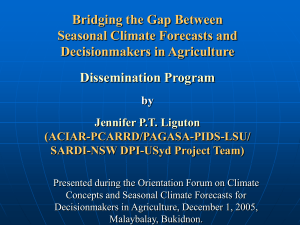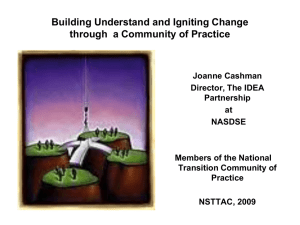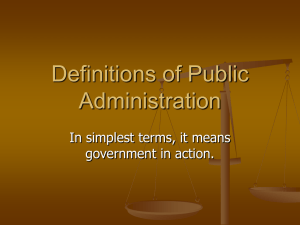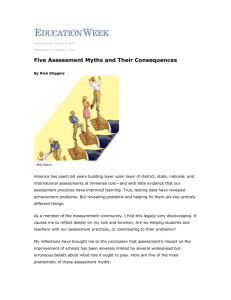Identifying Local Decision-Makers Module Two: Community Choices:
advertisement
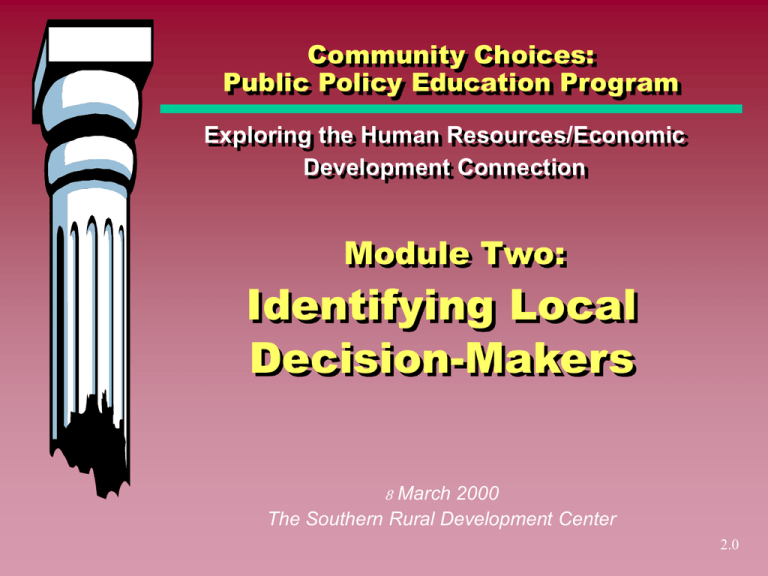
Community Choices: Public Policy Education Program Exploring the Human Resources/Economic Development Connection Module Two: Identifying Local Decision-Makers 8 March 2000 The Southern Rural Development Center 2.0 Objectives Understand the U.S. government and the importance of local government. Assess the role of social stratification in shaping local involvement. Understand the levels of influence in the community and learn techniques to identify these individuals. Community Choices: Identifying Local DecisionMakers 2.1 Objectives (cont). Appreciate the value of civic participation and some of the obstacles to participation and leadership. Gain greater sensitivity about the importance of including people who often are not heard in public policy deliberations. Community Choices: Identifying Local DecisionMakers 2.2 The U.S. System of Government U.S. has a federal system of government. Power and responsibility are shared among national, state, and local jurisdictions. Local governmental units function as administrative units of the states. Local governing agencies exert great influence on the way we live. Community Choices: Identifying Local DecisionMakers Local government is the key level in our national system to which most of us feel close ties. 2.3 The Impact of Social Stratification Our unique system of government calls for citizens to take an active part in local decision-making. Certain barriers to local issues exist. Various types of social differences lead to social stratification—a ranking process that assigns higher and lower values to individual characteristics. Community Choices: Identifying Local DecisionMakers 2.4 Items used to rank people . . . Race Gender Socioeconomic status (income, education, and occupation) Community Choices: Identifying Local DecisionMakers 2.5 People from different socioeconomic, racial, and gender backgrounds may have distinct interests, needs, and concerns. These differences tend to affect how people view public policy issues. Social stratification has much to say about how a community might deal with key policy matters and who ultimately Community Choices: Identifying Local DecisionMakers will benefit from these policy decisions. 2.6 Figure 1. Community Leadership Levels Levels I II III VI Roles Legitimizers Implementors Doers General Public 2.7 Legitimizers . . . People in the community whose approval is necessary to guarantee the success of important undertakings. People who get involved in projects having significant policy implications. People whose endorsement is important if groups hope to be successful in getting their goals accomplished. Community Choices: Identifying Local DecisionMakers 2.8 Implementors . . . Are the most active participants in community projects. Involvement usually limited to areas where they have technical or professional expertise. Role is to implement the plans and decisions arrived at or approved by legitimizers. Community Choices: Identifying Local DecisionMakers 2.9 Doers . . . Perform many of the project chores (stuffing envelopes, distributing information, etc.). Seldom involved in the planning and decision-making aspects of a project. Tend to be task-oriented in their activities. Community Choices: Identifying Local DecisionMakers 2.10 General Public . . . Includes a sizable number who never become involved in local activities. Some become active on an occasional basis. Their views are important, particularly on matters that affect them directly. Community Choices: Identifying Local DecisionMakers 2.11 Locating Local Influentials Two techniques for locating legitimizers—“positional” and “reputational.” Decisional approach is helpful in determining who the implementors are in the community. Social activity procedure tends to uncover the so-called doers of the community. Community Choices: Identifying Local DecisionMakers 2.12 Expanding Local Participation Public policy education is based on public participation. Expanding involvement of local citizens in addressing local issues is vital. Important to ensure that all perspectives and voices are heard in policy activities. This will require extra efforts to involve people of various racial, ethnic, gender, and socioeconomic backgrounds. Community Choices: Identifying Local DecisionMakers 2.13 Prepared by Lionel J. Beaulieu Southern Rural Development Center Mark H. Smith Wake Forest University March 2000 Community Choices: Identifying Local DecisionMakers 2.14

